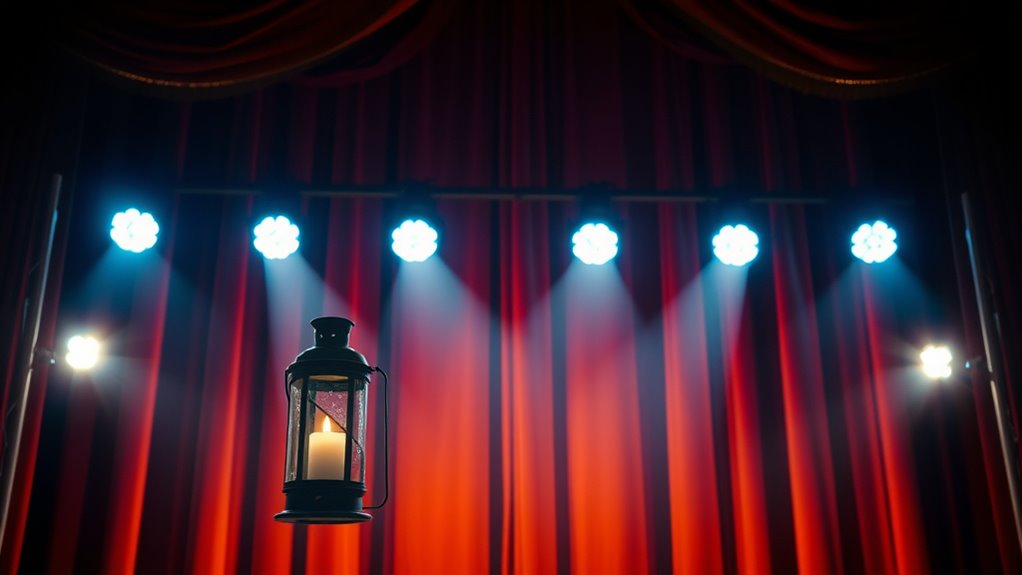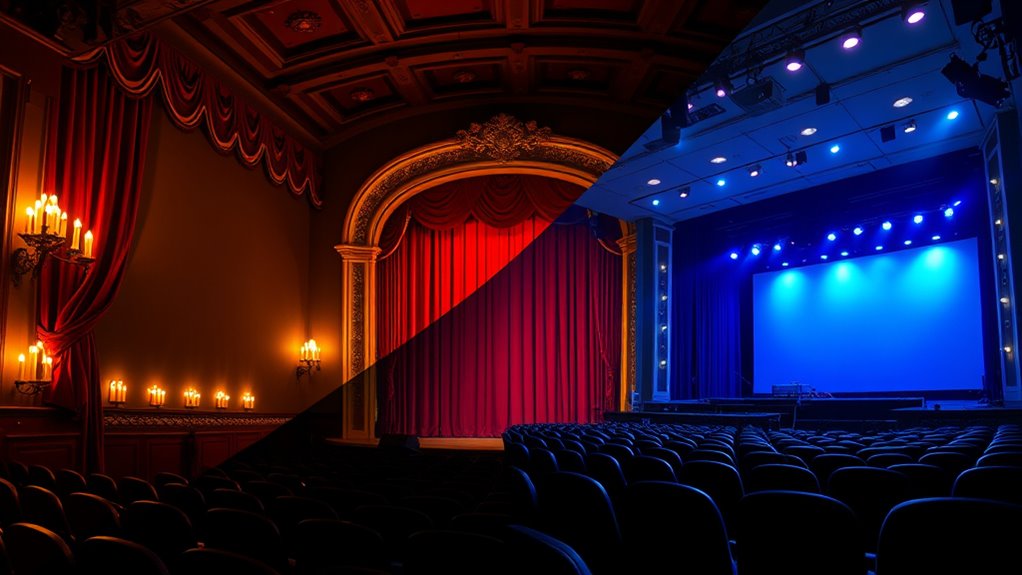You’ve seen how stage lighting evolved from simple candles and torches to advanced LED systems that craft mood and focus attention. Early performances relied on natural light, but innovations like gas lamps and electric bulbs allowed for greater control and creative effects. Today, LEDs offer energy efficiency and versatility, transforming theatre design. If you continue exploring, you’ll discover how these technological advances continue to shape theatrical storytelling and immersion.
Key Takeaways
- Stage lighting has evolved from natural and flame-based sources to electric lighting, improving control and visual effects.
- The invention of electric bulbs like Edison’s revolutionized theatre lighting with safer, brighter, and more versatile options.
- Modern technologies such as LEDs enable dynamic color changes, energy efficiency, and complex programming for immersive experiences.
- Historical advancements in lighting have shaped theatrical storytelling, mood-setting, and audience engagement.
- Sustainable lighting practices, including the use of eco-friendly LEDs, reflect ongoing innovation and environmental awareness in theatre.

Have you ever wondered how theatre productions create mood, focus attention, or transform a stage into different worlds? It all comes down to stage lighting, a powerful tool that shapes the audience’s experience. Over the years, the methods and technologies used for lighting have undergone a remarkable historical evolution. In ancient times, performances relied on natural light or simple flame-based illumination, like torches and candles, which limited control and flexibility. As theatre evolved, so did the tools used to light the stage. During the Renaissance, oil lamps and gas lighting made their debut, allowing for slightly more control over brightness and color. These advancements helped set the mood more precisely and made performances more visually dynamic.
Stage lighting has evolved from natural light and candles to sophisticated LEDs, shaping mood and transforming stage worlds.
The 19th century marked a turning point with the advent of electric lighting. Thomas Edison’s invention of the incandescent bulb revolutionized stage lighting, providing a safer, brighter, and more reliable source of illumination. This new technology gave lighting designers greater freedom to craft atmospheres, emphasize certain scenes, or highlight actors. The historical evolution didn’t stop there; it continued through the 20th century with innovations like spotlights, floodlights, and dimming systems, which allowed for more nuanced control of the stage environment. These developments made it possible to change lighting effects quickly and seamlessly, matching the shifts in mood, time, or location on stage.
Today, stage lighting has become an art form in itself, blending technology with creativity. Modern lighting fixtures, such as LEDs, are energy-efficient and versatile, capable of producing an array of colors and effects that were impossible with earlier methods. The evolution from candlelit stages to LEDs reflects a broader trend of technological progress, pushing the boundaries of what’s possible in theatre. Lighting designers now use sophisticated control consoles to program complex cues that enhance storytelling, evoke emotions, and immerse viewers in different worlds. This ongoing historical evolution continues to shape how stories are told on stage, making each production more engaging and visually stunning. Additionally, sustainable lighting practices are increasingly being adopted to reduce environmental impact and promote eco-friendly theatre.
Understanding this progression helps you appreciate the craftsmanship behind every scene change or mood shift you see in theatre. From humble candlelit beginnings to cutting-edge LED systems, stage lighting has always been about more than illumination—it’s about creating a world, focusing attention, and enriching the theatrical experience.
Frequently Asked Questions
How Do Stage Lighting Designers Choose the Right Color Palette?
You choose the right color palette by considering color psychology and lighting design techniques. Think about how different colors evoke emotions and set moods, aligning with your story’s themes. Use techniques like layering and color mixing to create depth and focus. Test your choices under different lighting conditions, ensuring they enhance the scene’s atmosphere. Ultimately, your goal is to use color intentionally to support the narrative and engage your audience.
What Safety Precautions Are Necessary for Stage Lighting Setups?
Your safety on stage is vital, and ignoring precautions could lead to a fire hazard that’s as dangerous as a wildfire. You must guarantee proper electrical safety by inspecting cords regularly and avoiding overloading circuits. Always keep fire extinguishers nearby, disconnect equipment when not in use, and follow manufacturer instructions. These steps help prevent accidents, protect performers, and keep your stage a safe, shining space for everyone.
How Has LED Technology Impacted Theatre Production Costs?
LED technology has considerably impacted theatre production costs by enabling cost reduction through lower energy consumption and longer-lasting bulbs. You’ll notice reduced electricity bills because LEDs are highly energy efficient, and maintenance costs decrease since they don’t need frequent replacements. This shift helps you save money over time, making productions more budget-friendly while maintaining excellent lighting quality. LEDs truly revolutionize theatre lighting by combining affordability with sustainability.
What Are the Environmental Benefits of Modern Lighting Choices?
Imagine a stage bathed in soft, eco-friendly light that not only enhances performances but also champions sustainable practices. Modern lighting choices boost energy efficiency, reducing your carbon footprint and conserving resources. By switching to LED fixtures, you help protect the environment, cut down on waste, and promote greener theatre production. Your choices make a difference, turning each performance into a celebration of innovation and environmental responsibility.
How Do Lighting Cues Synchronize With Sound and Actor Movements?
You synchronize lighting cues with sound and actor movements through lighting automation, which allows precise cue timing. By programming cues to trigger at exact moments, you guarantee seamless shifts that match the actors’ actions and sound effects. This coordination enhances the overall performance, creating a cohesive atmosphere. As a result, your lighting design complements the storytelling, making every scene more immersive and impactful for the audience.
Conclusion
So, next time you sit in a darkened theatre, remember how lighting transforms the stage. It’s easy to think, “It’s just lights,” but those candles and LEDs craft moods, reveal characters, and bring stories alive. Imagine a dim glow, flickering like a candle, or a brilliant spotlight illuminating a hero—lighting isn’t just background; it’s the silent storyteller. Without it, the magic of theatre simply wouldn’t shine as brightly.








